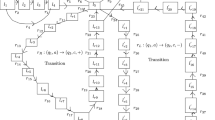Abstract
The generative capacity of splicing grammar systems is investigated in this paper. It is proved that: 1) any linear language can be generated by a splicing grammar system with two regular components; 2) any context-free language can be generated by a splicing grammar system with three regular components; 3) any recursively enumerable language can be generated by a splicing grammar system with four right linear components. The first two results answer a problem left open in [18], the last result improves results in the same paper.
Research supported by the Academy of Finland, project 11281.
Preview
Unable to display preview. Download preview PDF.
Similar content being viewed by others
References
L. M. Adleman, Molecular computation of solutions to combinatorial problems, Science, 226 (Nov. 1994), 1021–1024.
E. Csuhaj-Varju, J. Dassow, J. Kelemen, Gh. Păun, Grammar Systems. A Grammatical Approach to Distribution and Cooperation, Gordon and Breach, London, 1994.
E. Csuhaj-Varju, R. Freund, L. Kari, Gh. Păun, DNA computing based on splicing: universality results, First Annual Pacific Symp. on Biocomputing, Hawaii, Jan. 1996.
E. Csuhaj-Varju, L. Kari, Gh. Păun, Test tube distributed systems based on splicing, Computers and AI, 15, 2–3 (1996), 211–232.
J. Dassow, V. Mitrana, Splicing grammar systems, Computers and AI, 15, 2–3 (1996), 109–122.
C. Ferretti, S. Kobayashi, T. Yokomori, DNA splicing systems and Post systems, First Annual Pacific Symp. on Biocomputing, Hawaii, Jan. 1996.
R. Freund, L. Kari, Gh. Păun, DNA computing based on splicing: The existence of universal computers, Technical Report 185-2/FR-2/95, TU Wien, 1995.
V. Geffert, Normal forms for phrase-structure grammars, RAIRO, Th. Inform. and Appl., 25 (1991), 473–496.
T. Head, Formal language theory and DNA: an analysis of the generative capacity of specific recombinant behaviors, Bull. Math. Biology, 49 (1987), 737–759.
T. Head, Splicing schemes and DNA, in Lindenmayer Systems: Impacts on Theoretical Computer Science and Developmental Biology (G. Rozenberg, A. Salomaa, eds.), Springer-Verlag, Berlin, 1992, 371–383.
T. Head, Gh. Păun, D. Pixton, Language theory and molecular genetics. Generative mechanisms suggested by DNA recombination, in Handbook of Formal Languages (G. Rozenberg, A. Salomaa, eds.), Springer-Verlag, 1997.
L. Ilie, A. Salomaa, 2-Testability and relabelings produce everything, submitted, 1995.
V. Mihalache, Parallel communicating grammar systems with query words, Ann. Univ. Buc., Matem.-Inform. Series, 45, 1 (1996), 81–92.
Gh. Păun, Splicing. A challenge to formal language theorists, Bulletin EATCS, 57 (1995), 183–194.
Gh. Păun, On the splicing operation, Discrete Appl. Math., 70 (1996), 57–79.
Gh. Păun, On the power of the splicing operation, Intern. J. Computer Math., 59 (1995), 27–35.
Gh. Păun, Regular extended H systems are computationally universal, J. Aut. Lang. and Combinatorics, 1, 1 (1996), 27–36.
Gh. Păun, On the power of splicing grammar systems, Ann. Univ. Bucharest. Matem.-Inform. Series, 55, 1 (1996), 93–106.
Gh. Păun, Computationally universal distributed systems based on the splicing operation, submitted, 1995.
Gh. Păun, G. Rozenberg, A. Salomaa, Computing by splicing, Theor. Comp. Science, 168, 2 (1996), 321–336.
Gh. Păun, A. Salomaa, DNA computing based on the splicing operation, Acta Mathematica Japonica, 43, 3 (1996), 607–632.
D. Pixton, Regularity of splicing languages, Discrete Appl. Math., 69 (1996), 101–124.
Gh. Păun, L. Santean, Parallel communicating grammar systems: the regular case, Ann. Univ. Buc., Matem. Inform. Series, 38 (1989), 55–63.
D. Pixton, Linear and circular splicing systems, Proc. 1st Intern. Symp. on Intell. in Neural and Biological Systems, IEEE, Herndon, 1995, 38–45.
A. Salomaa, Formal Languages, Academic Press, New York, London, 1973.
T. Yokomori, S. Kobayashi, C. Ferretti, On the power of circular splicing systems and DNA computability, Report CSIM 95-01, Univ. of Electro-Comm., Chofu, Tokyo, 1995.
Author information
Authors and Affiliations
Editor information
Rights and permissions
Copyright information
© 1997 Springer-Verlag Berlin Heidelberg
About this chapter
Cite this chapter
Georgescu, G. (1997). On the generative capacity of splicing grammar systems. In: Păun, G., Salomaa, A. (eds) New Trends in Formal Languages. Lecture Notes in Computer Science, vol 1218. Springer, Berlin, Heidelberg. https://doi.org/10.1007/3-540-62844-4_24
Download citation
DOI: https://doi.org/10.1007/3-540-62844-4_24
Published:
Publisher Name: Springer, Berlin, Heidelberg
Print ISBN: 978-3-540-62844-6
Online ISBN: 978-3-540-68703-0
eBook Packages: Springer Book Archive




